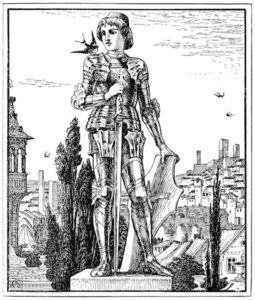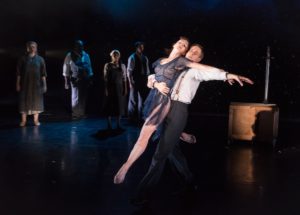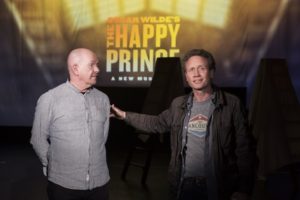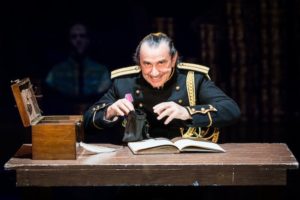“Angels you will see only when you’re dead. Possibly.”
by Mika Provata-Carlone
Illustration by Walter Crane for the first edition of The Happy Prince and Other Tales, 1888. Wikimedia Commons
Think back to when you were very young, still capable of looking at the world with wide, wondrous eyes. When books had a breathtaking pulse and three-dimensionality about them, and every page seemed like an invitation to a mystic dance – a summons to enter a world of grand enchantment, of dark, mysterious corners and luminous spaces, a universe of myth and reality where nothing else mattered. Where you were able to fall in love with princes or princesses, flower-girls and common dustmen. Feel deeply, suffer unbearably, laugh out loud. A place where your heart skipped several beats to know the fate of characters whose fictionality was as vital, as palpably alive, as perhaps little else in the entire world. Think back to the stories that gave your childhood its tones and hues, that shaped you, marked you, changed you for life.
Such stories have a rare genius about them: they may even surpass in craft, gifted inspiration and talent anything that adult stories – ‘proper stories’ – might lay claim to. That genius is their ability to capture in the simplest, purest, most unmediated form the very essence of our humanity, our fragility, our yearning need to be all that we are, to connect with everything there is. Few possessed this genius more hauntingly and spectacularly than Oscar Wilde. His stories for children, published in 1888 under the title The Happy Prince and Other Tales, were groundbreaking, extraordinary, intimately and urgently evocative of a finer sensibility and psyche. They were a private confession of gentleness, a daring lesson in individual and collective responsibility. They show the way to a better state of ourselves as well as exposing all that is rotten, tragic, wasted in things as they are, as we accept them to be.
One cannot read the story of The Happy Prince and not be touched by its desperate vision and dire trauma; the beauty and power of its message of love and the stark pathos that lies at its heart.”
The Happy Prince, together with The Selfish Giant, are the undisputed masterpieces in the collection. They evince a degree of tragedy, dramatic power and sense of human purpose that have rarely been matched, if at all. Unlike Hans Christian Andersen’s stories, where the narrator is a reflected, detached observer, or Selma Lagerlof’s more expansive, fanciful and often uncanny, Peer Gynt-like Nils Holgersson, Wilde implicates his readers almost relentlessly, makes them complicit in both the fatality of error and the way to a redemptive hope. One cannot read the story of The Happy Prince and not be touched by its desperate vision and dire trauma; the beauty and power of its message of love and the stark pathos that lies at its heart.
And yet it seems that Wilde’s stories for children are growing dusty on the bookshelves, encumbered by impressive editions and heavy-hearted bindings. Refreshingly, in Hal Cazalet and Michael Barry, The Happy Prince finds two true and inspired champions of everything that the story can still reveal and enchant us with. Their recent production of The Happy Prince at The Place was an extraordinary feat in the true magic of ‘less is more’, in heuristic stagemanship that left the audience mesmerised and transported. Taking their cue from the performative intimacy of the story, they have given it on the stage a particularly haunting and effective frame of reference: Wilde’s Victorian London, squalor, glamour, ambition and fragile passion delivered with dazzling pace. Their own genius is to pare down in order to enhance; to create a highly memorable libretto that will accompany the audience, in the same way that ‘supercalifragilisticexpialidocious’ has done for so many generations. Exuberant, imaginative, utterly enchanting, this Happy Prince is a children’s musical for the present and future generations.
Cazalet and Barry do not shy away from the story’s politics, its deliberate moral core, Emerson’s injunction that you “cannot do a kindness too soon, for you never know how soon might be too late.” Their adaptation is full of sparkling humour and radical social commentary, deeply moving brittleness and terrific strength. This is a production that deserves attention, a bewitched audience, a stage of its own. It was a very great pleasure to interview Hal Cazalet, director, composer and lyricist of The Happy Prince, following its brief run.
MP-C: Musician, actor, singer, lyricist, director, producer – what made you choose such a path?
HC: Inner rebel, I think! I have always wanted to tread my own path, and through performing all my life felt it only possible to combine my writing into the mix with the things I know now. It’s a long road which cannot be rushed – you can only earn experience, and I suppose that in turn informs you of what you should be doing.
Why are the theatre and its people, the world on the stage and its audience important to you?
The theatre is the world I think, write and imagine in. I write visually and see everything on a stage. The audience is of course crucial to the writer and the performer, as it is only then you have a reaction to your work. Prior to this moment, one lives in a permanent state of destructive self-judgement, a kind of self-induced purgatory! However, the world ‘on stage’ is our playground – a playground because it is full of variety, invention and possibilities. No performance is ever the same twice, but constantly evolving. I am astonished and humbled by the way dancers, actors, choreographers interpret the material, always giving you back things in a way you could never have dreamed of. We all learn together. This only comes from opening the doors to total collaboration. Give talent in the room, room. I have learned so much during this process.
The Happy Prince is a musical that harkens back to the genre’s glory days – My Fair Lady, Mary Poppins, Les Misérables, even Cats. It combines both poise and irresistible allure, old-world charm and finesse and a very modern resonance and appeal. What inspired you to create this musical opera for children? What do you hope it will bring into their lives?
As Oscar Wilde said, The Happy Prince is a story for both adults and children alike, and I hope that is what this musical achieves. Wilde deliberately wrote these short stories as ‘allegorical fairy tales’ based on Christian principles and moral teachings. Adults are humbled and continue to learn from them, while children are taught to understand the meaning of kindness and compassion.
Oscar Wilde clearly moves you and fascinates you, has informed you as a person and as an artistic creator. Do you feel that we have truly come to know him?
I feel the most important thing in creating any adaptation for the stage is to honour the author. I read the story when I was a child and it moved me and I always saw it on a stage. It is such an important story that I found myself constantly searching for the truth in every moment as I wrote the score and shaped the lyrics. I hope the audience came to know Wilde the man through this musical telling a little. I feel that if the audience is sent away with the same essence and emotional sentiment of the Wilde story, then as writers Michael Barry and I have tried to honour Wilde to the best of our abilities.
Wilde’s genius and personality were full of complexities… It seems his children revealed the quiet and private side of him, while in stark contrast, Wilde’s public persona was always on show.”
Wilde the public dramatist and Wilde the private storyteller: panache and hyperbole on the one hand, a quiet yet almost overwhelming dramatic poignancy, and paring down of the details on the other. Grand spectacle meets minimalist parable. How do the two connect and contrast in your view?

Sophia Hurdley as The Swallow and Sam Archer as The Prince, dancing the final pas de deux © David Jensen
Yes, a wonderful observation! Wilde’s genius and personality were full of complexities. Unlike Hans Andersen (to whom Wilde, the writer, was much compared) Wilde’s fairy tales are not only shorter, but far more sophisticated. I love the fact that he read them to his two young sons as a bedtime story. It seems his children revealed the quiet and private side of him, while in stark contrast, Wilde’s public persona was always on show. I think it was these opposite forces in him which produced such variety and compelling work.
From the page to the stage to the music score: tell us about the process of transforming The Happy Prince for the theatre.
Lyrics come with the music, inspired by the Wilde text. For example, in the Wilde story, the Swallow describes Egypt in all its exotic beauty. I moulded these images into lyrics, so Egypt is brought to life in a rich pageant in a song. In theatre you have to ‘show’ and take time to explore the characters Wilde only mentions in passing. They have to live and breathe, and matter. You have to dramatise the conflict in the story – the corruption of the Mayor set against the virtue of the Prince, and show how the characters suffer in a town riddled with greed and hypocrisy.
Why is The Happy Prince important to us still?
Quite incredibly, nothing has changed in our world since Wilde wrote the tale in 1888. Unlike the children, adults also relate to this story through the satire, being forced to laugh with a certain unease. Wilde railed against the injustice of Victorian society, illustrating the haves and the have-nots. There is still just the same social imbalance today. The Happy Prince is a fairy tale for modern times, just as relevant its theme that one small act of kindness is worth more than the grandest gesture.
The performances of The Happy Prince at the Place on 3 and 4 May were meant to showcase your vision for this “fairy tale for modern times”. Tell us more about this vision, what are the next stages and steps?
I hope it reaches the next stage, which is on a more ‘public’ stage. It is a beautiful and important story. Its message is vital and urgent. I hope at least this musical adaptation will send folks back to Wilde’s writings, especially to these delicate fairy stories that are hidden gems, which need to be brought back into our society. And how fun it would be to perform this show in India, for example – the Indian prince trapped in a palace who sheds his royal robes for a monk’s cloak to seek enlightenment – the story of the Buddha. You see, its theme is universal!
Imagination and resilience; aspiration and perseverance; the will to go on, create more, dream more no matter what, these are terms that seem to describe so much of your work over the years. Your advice to the young (or perhaps also to the old)?
Whatever you do, reveal your heart. How else will anyone understand what you mean?

Hal Cazalet – Composer/Lyricist (right) and Michael Barry – Book (left) introduce the musical to the audience © David Jensen
Hal Cazalet trained at the Guildhall School of Music in London and the Julliard Opera Center in New York, where he won the Shoshana Foundation Award. He divides his time between the USA and Europe performing in opera, musical theatre and cabaret. As a composer and lyricist, he has written stage musicals Street People, which was performed at the 1989 Edinburgh Fringe Festival and First Night, which was performed at the 1996 Aspen Music Festival and in New York directed by Frank Corsaro. He has also written various instrumental and choral works. His Agnus Dei was performed at the 1998 Santa Fe Festival and on BBC Radio 3. The Happy Prince, with music, lyrics and direction by Hal Cazalet and book and movement direction by Michael Barry, is set in a 1920s laundry house located in a town where a despotic mayor drives the citizens to financial ruin. Appearing in the showcase performances at The Place were Janie Dee, Phil Daniels, Sophia Hurdley and Sam Archer.
theplace.org.uk
Mika Provata-Carlone is an independent scholar, translator, editor and illustrator, and a contributing editor to Bookanista. She has a doctorate from Princeton University and lives and works in London.


